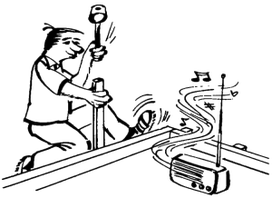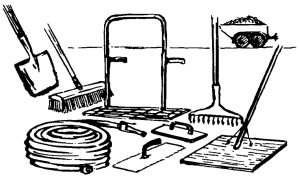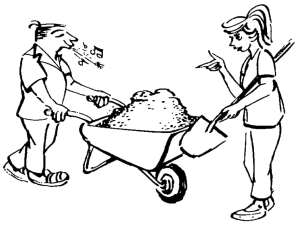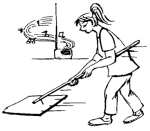|
1. To Begin - Make Plans!
A project made with concrete is so permanent that it will become a lasting monument to your lack of planning! Make sure you know exactly what you're going to do and who's going to help you before the concrete arrives! Stake out the area you will cover. Make sure that water will drain away from buildings and that you do not interfere with tree roots! Remove grass, level your ground (use a carpenter's level), fill in the spots and then pack and dampen the area. |
|
2. Forms
Use 2" x 4" planks set on edge. Hold the 2" x 4" in place with stakes driven into the ground every 18 inches. The stakes must be on the outside of the forms and must be even with the top of the forms.
Use 2" x 4" planks set on edge. Hold the 2" x 4" in place with stakes driven into the ground every 18 inches. The stakes must be on the outside of the forms and must be even with the top of the forms.
|
If your concrete will be poured next to an existing concrete slab, you must insert an expansion joint between the old slab and the new pour (you can obtain the expansion joint material at any building material yard).
OPTION: You can nail together a grid-work of permanent dividers and place them inside your forms for decorative effect. These dividers must be rot resistant cedar or redwood and nails must extend from them to anchor them in the concrete. |
3. Gather your tools
4. Make sure you have Several People to help you! (at least three people for three yards or less of concrete)!
|
Wet your area several times the night before you pour your concrete and sprinkle the ground once before the cart arrives. This insures a good cure and also keeps the ground from drawing water from the concrete (you will have more time to work the concrete before it sets).
Pour concrete out of the trailer or wheelbarrow. Begin at the far end of the forms and dump each load close to the last. Use square nose shovels and rakes to spread the concrete evenly to top of the forms. |
|
5. Have Two People use a screed Board to level the concrete, moving back and forth in a sawing motion as well as across the concrete. |
6. Use a Tamper to bring moisture and sand to the surface and to move large aggregate down into the concrete. Don't be afraid to step out on the concrete but make sure you always move in a backward direction, covering your footprint as you go.
|
|
Concrete Facts:
Too much water weakens the Concrete causing sandy surfaces, peeling and chipping. Too little moisture causes the Concrete to cure too fast and will result in wind check and cracking. Concrete will reach half it's strength in 10 days and it's full strength in 27 days. Hot days or windy days can affect the finish of your job. |
|
Cement VS. Concrete
Although the terms cement and concrete often are used interchangeably, cement is actually an ingredient of concrete. Concrete is a mixture of aggregates and paste. The aggregates are sand and gravel or crushed stone; the paste is water and portland cement.
Although the terms cement and concrete often are used interchangeably, cement is actually an ingredient of concrete. Concrete is a mixture of aggregates and paste. The aggregates are sand and gravel or crushed stone; the paste is water and portland cement.









